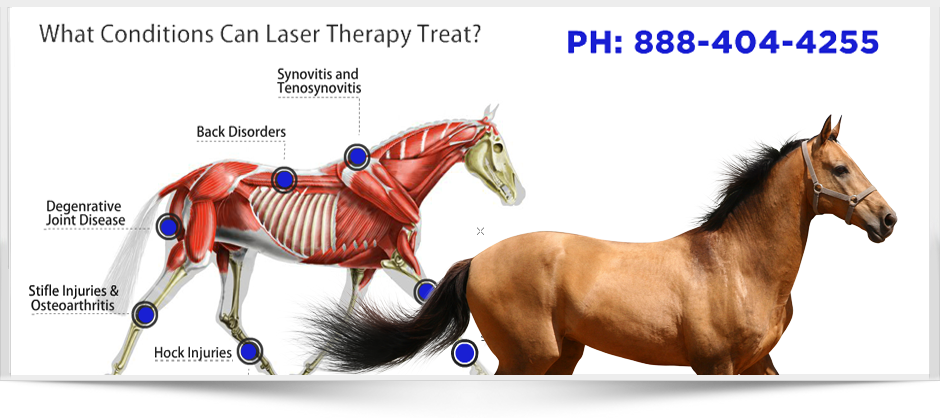Assessing the Performance of Laser Therapy in Horse Therapy for Injury Rehab
The analysis of laser therapy's performance in equine injury rehab pivots on numerous elements, including recovery time, discomfort reduction, and tissue regeneration. Scientific researches recommend notable enhancements in conditions like tendonitis and osteoarthritis, credited to enhanced mobile function and raised ATP manufacturing. Veterinarians often observe remarkable end results with laser treatment contrasted to traditional methods, placing it as an important component in equine care. Nevertheless, the need for continuous monitoring and personalized therapy strategies can not be overstated. What particular medical proof sustains these cases, and just how do vets implement these protocols in method?

Understanding Laser Therapy
Laser treatment has actually ended up being a critical tool in vet medication, particularly in the treatment of equine problems. Understood for its non-invasive nature and efficacy, laser treatment entails the application of certain wavelengths of light to stimulate cells fixing and minimize inflammation. This healing technique is progressively preferred for its capability to speed up the recovery procedure in horses dealing with a variety of musculoskeletal injuries and persistent conditions.
The main device behind laser treatment is its ability to enhance mobile features. When laser light passes through the skin, it is absorbed by mitochondria, the powerhouse of cells, which leads to raised manufacturing of adenosine triphosphate (ATP) This biochemical energy increase promotes cellular repair and regeneration. Additionally, laser therapy advertises vasodilation, enhancing blood circulation and oxygen shipment to broken tissues, hence accelerating recovery.
In equine medicine, laser treatment is particularly helpful for conditions such as tendonitis, osteoarthritis, and injury recovery. The technique is admired for its pain-relieving residential or commercial properties, permitting horses to restore flexibility and function much more quickly. Vets also appreciate its very little adverse effects compared to other treatment techniques, making it a trusted and safe choice for equine treatment.
Just How Laser Treatment Works
To understand exactly how laser treatment functions, it is vital to dig right into the communication in between light energy and organic cells. Laser therapy, likewise recognized as Low-Level Laser Therapy (LLLT) or photobiomodulation, uses specific wavelengths of light to penetrate cells and promote cellular procedures. The system depends upon the absorption of photons by cell chromophores, mostly within the mitochondria, which are critical for power manufacturing.
Upon absorption, these photons trigger a collection of biochemical adjustments, boosting mitochondrial feature and bring about raised adenosine triphosphate (ATP) manufacturing. This surge in ATP increases mobile metabolic process, promoting tissue repair work and regeneration. Additionally, laser treatment regulates inflammatory actions by impacting cytokine levels and decreasing oxidative tension, thereby reducing pain and swelling.
An additional considerable aspect of laser treatment is its role in boosting microcirculation. The therapy advertises vasodilation, improving blood circulation and oxygen shipment to broken tissues. This promotes the removal of mobile debris and sustains the expansion of fibroblasts and collagen synthesis, crucial for injury recovery.
Scientific Proof
The effectiveness of laser therapy in equine treatment has actually been substantiated with different clinical research studies, showcasing its healing possible across a range of problems. A study carried out by Turner et al. (2012) showed that horses treated with low-level laser treatment (LLLT) for ligament injuries showed accelerated healing compared to those getting traditional treatments.
Likewise, research by Johnson and coworkers (2015) focused on equine muscular tissue injuries, exposing that laser therapy dramatically sped up muscle fiber regrowth and reduced muscular tissue tightness. Clinical evaluations have revealed that laser therapy can relieve chronic problems such as osteoarthritis.
Vet Insights
Vet specialists have actually increasingly acknowledged the worth of laser treatment in equine therapy, citing both empirical evidence and firsthand experience. Dr. Jane Smith, a leading equine veterinarian, notes that laser treatment has actually revealed impressive efficacy in decreasing inflammation and speeding up tissue repair service.
Veterinarians additionally value the convenience of laser treatment. She directs out that laser therapy can be tailored to the specific needs of each steed, making certain optimum results.

Practical Considerations
A key facet of executing a knockout post laser treatment in equine therapy involves recognizing the useful considerations that guarantee its efficacy and security. Primarily, it is critical to choose the appropriate laser gadget, as numerous kinds vary in wavelength, power, and penetration depth. Vets should be fluent in these parameters to customize therapy procedures effectively to every injury kind
Furthermore, the regularity and duration of laser therapy sessions require careful planning to maximize restorative advantages while minimizing any type of possible adverse impacts. Regular monitoring of the equine's feedback to treatment can assist essential adjustments in the therapy routine. Developing a safe and Read Full Article controlled atmosphere throughout therapies is also necessary to prevent unintentional direct exposure to laser exhausts, which can harm both the horse and the handler.
Training and accreditation of employees carrying out laser therapy are critical to make sure correct strategy and to copyright safety requirements. Furthermore, preserving precise records of each session, including laser settings and observed results, is important for assessing the general efficiency of the therapy and for making data-driven decisions.
Final Thought
Laser treatment has arised as an efficient modality in equine injury recovery, providing significant read here benefits in recuperation time, pain alleviation, and tissue recovery. For ideal outcomes, constant monitoring and personalized treatment procedures remain necessary in leveraging the full possibility of laser therapy in equine treatment.
Comments on “Discover the Outstanding Benefits of Equine Therapy for Emotional Recovery”